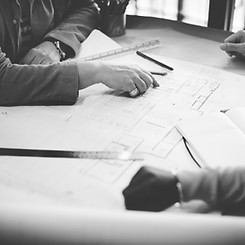

For Whom

Design for Blooming supports architects, designers, practitioners, and developers leading the shaping of the built environment, as well as organizations and communities ready to unlock their full potential. Together, we transform the spaces where people live, work, learn, and connect.
We offer an evidence-based toolset and tailored consultancy to meet your unique needs—whether for new projects, renovations, or post-occupancy strategies in corporates & organizations, real estate & hospitality, residential, education, community, or urban planning—to create environments where people and places truly bloom.
Let’s explore together how intentional design becomes the foundation for lasting success and meaningful impact.
Architects, Designers & Practitioners

Great spaces begin with vision, but turning vision into reality requires insight grounded in human experience. Evidence-based strategies, informed by science, help identify opportunities and guide decisions to create meaningful, human-centered environments. Applying a science-based framework during the design process ensures that every choice supports both people and place.
By bridging research and design, projects gain depth, resilience, and impact. Environments shaped with this approach don’t just function—they support well-being, foster connection, and help communities thrive.
Design professionals can elevate their practice, delivering spaces that are thoughtful, scientifically informed, and truly enriching for those who inhabit them.
Corporates & Organizations

When people thrive, organizations thrive. Creating the conditions for growth starts with understanding what truly supports a team—emotionally, mentally, and physically.
Workspaces are more than just places to get things done. They shape how people feel, connect, and perform. When designed with intention, they reduce stress, inspire motivation, and support a culture of well-being.
In today’s fast-paced world, a thoughtful work environment is no longer a luxury—it’s a strategic asset. It strengthens teams, fuels innovation, and reflects organizational values.
Investing in spaces that support well-being and effective work enables organizations to bloom—from the inside out.
Real Estate & Hospitality

Investing in new spaces means more than capital—it’s about energy, vision, and the dreams behind the project. Launching a new development comes with challenges, and a human-centered approach to space planning helps maximize resources and lay a foundation for lasting success.
Today, spaces are no longer just places for transactions. In a world where shopping is often done online, people seek meaningful experiences—places that inspire, move, and connect.
At a time when loneliness and disconnection are growing, your space can become vital hubs for engagement and well-being. These spaces don’t just attract visitors—they create loyal communities and set new standards for what environments can offer.
When people feel alive in a space, they don’t just return—they want to see more places like it thrive.
Schools & Educational Centers

New generations deserve to thrive in environments that connect them to nature, diversity, and their own growth. Traditional education often misses this, limiting children’s exploration and connection to natural rhythms and biodiversity.
Learning spaces shape how students move, feel, and develop—supporting physical health, emotional well-being, and brain growth. Exposure to nature enhances these benefits and builds empathy for both the environment and ourselves.
When students feel connected and understood, their motivation and potential naturally flourish. Teachers need supportive spaces too—when they thrive, they inspire students, creating a positive cycle of growth across the entire school community.
Municipalities & City Makers

Municipalities carry the vital role of balancing diverse community needs while managing resources and policies.Their mission is to enhance quality of life, promote public health, lower healthcare costs, and drive meaningful environmental action.
Achieving this requires a genuine understanding of people’s real needs, experiences, and aspirations.
Cities are more than buildings—they are lived environments that shape how we see ourselves and connect with others. Public spaces like streets, parks, and plazas serve as essential places for social interaction, movement, and restoration.
When thoughtfully designed, these spaces reduce stress, support biodiversity, and engage our senses—helping create healthier, more vibrant, and resilient communities.